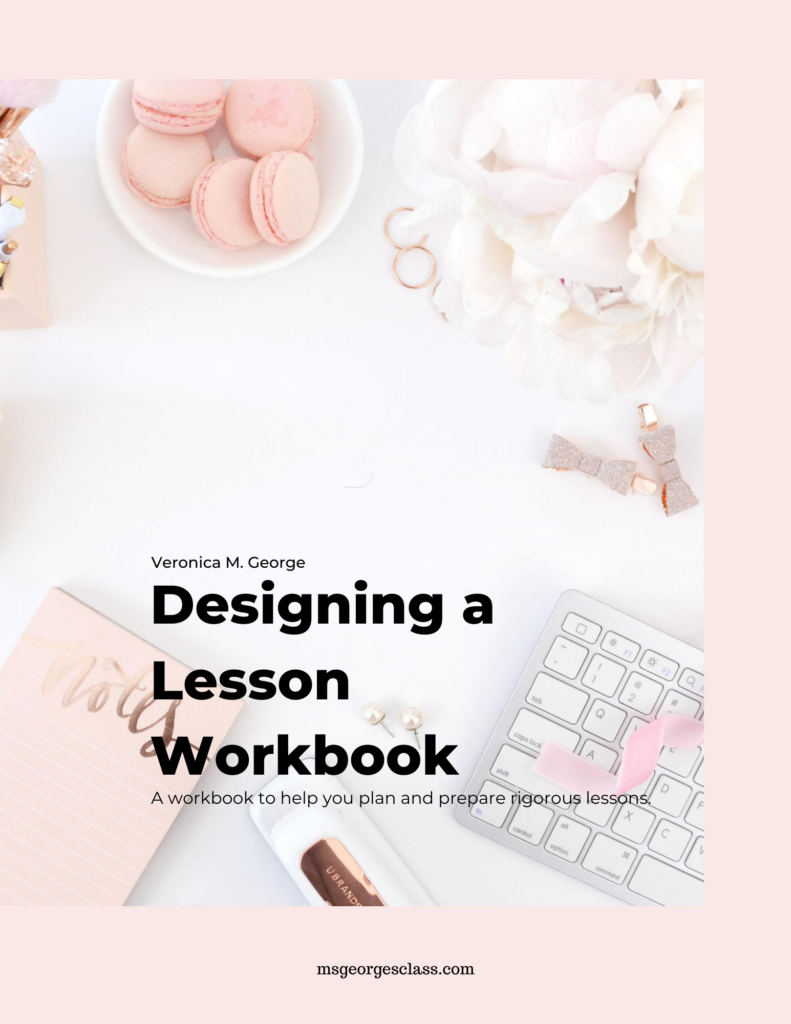
After a less than stellar teacher walkthrough completed by my principal, I knew that I had to change my instruction strategy. My old way of teaching was not working, and I knew that I had to design lessons that work for every student. I began reading teachers’ professional books and focusing on learning. I read the state standard of teacher thoroughly with a highlighter. I was consumed with learning how to instruct my students better. It was my job and my passion. The wealth of knowledge I gained was developed into my Designing a Lesson Workbook. The workbook changed how I planned lessons that are more complex and more in-depth for all my students. In this workbook, you will reflect on what you want your students to learn, state clear learning goals, use various strategies, and assess students. This instructional planning guide will help you become more focused, your students will be challenged, and your principal will note the changes in your lessons.

Taking Back Your Weekends
I have been teaching since 2002, and I have the expertise and knowledge to teach English Language Arts. I have worked on the district’s pacing guide twice, designed the district’s 10th grade assessment twice, and earned the Master Teacher License in 2017. Recently, I was named OCTELA’s Outstanding ELA Educator for Middle School. Believing that learning is a lifelong trait, I continued to engage in my reading to learn about teaching. My personal library is filled with countless books about being a better teacher, autobiographies, and literature. The knowledge I have gained led me to create the Designing a Lesson Workbook. I have been there, taking hours to create weekly lessons. My evaluator was very detail-oriented, and I wanted my lesson plans to be stellar. However, I didn’t want to take hours developing them. The long hours creating a lesson plan planted the seed for wanting my weekend back. No longer was I going to create a lesson plan from the beginning without an end in mind. I was going to scaffold learning with checkpoints along the way.
What’s My Secret?
First, I used the workbook as a unit guide or an instructional planning guide, and then I developed weekly lessons. Second, I learned all the common core standards for the grade level. Learning the standards will save you time in researching standards for the lesson. I wrote the standards down, I used them while teaching, and I wrote them on the students’ assignments. Students understood where they were going with the lesson and could reflect on the standard. The learning target also guides students in completing an assignment. Next, I knew that, if I taught a concept, I would need help teaching it, like a strategy. I have to admit, as an English teacher, I am prone to using summarizing or comparing and contrasting strategies. When students can explain the passage they just read or contrast the traits of two passages, it demonstrates that they are learning. These strategies are challenging, especially discussing the contrasting traits. Finally, I assess my students’ learning by the end of each class. Did the students learn the concept? Do they have any questions? Do I need to reteach anything? Assessing my students before they left each class helped me learn about them and their learning.
How has an Instructional Planning Guide Helped Me?

I have used the Designing a Lesson Workbook as a starting and ending point. I have created a unit plan with an end in mind. No longer am I guessing where to go or what standard to begin with for a lesson plan. I look at my calendar and see where I am going, what students should learn by the end of the week, and how I am going to assess them. Now, I am able to spend less time creating lessons because I am scaffolding on the lesson from the previous week and reaching for the ultimate goal of the unit. I am aligning my instructional goals and applying the knowledge of students to create strategies that will allow them to win. On my class list, I highlighted the students that are identified as exceptional, and it helps to modify their work. I know my students’ strengths and weaknesses, which allows me to create lessons that are differentiated instruction and cater to their strengths in the instructional planning guide.
Why Do I need Designing a Lesson Workbook?
Novice to veteran teachers needs guidance to create lessons that will increase their students’ knowledge and improve test scores. From my experience, I thought my lessons were fine until I began working at an award-winning school. I immediately noticed that I was missing something, but I did not know what it was. Then I began reading and taking notes at professional developments. I learned about teachers’ standards and how to develop a lesson plan where I taught to every student. This workbook has the ability to change your outlook on teaching because it makes you intentional about your teaching. You will have a beginning and an ending for your lesson. At the end of each class, you will have an intentional snapshot of each of your student’s learning abilities. As a result, you will make your students independent learners that are willing to take challenges because you provided them with the scaffold they needed.

Designing a Lesson Workbook is for every teacher that wants to improve their instruction and see immediate results. I had to be intentional about my teaching skills, and I knew there was more than using the teacher edition to guide. Do you want to create lessons that are engaging, align with the state standards, and promote students to think critically and independently? You can start making changes now with these easy steps. You can provide meaningful lessons and take back your weekend. Creating lessons will take less time because you will have a unit plan to guide you, and you will assess your students’ strengths to get them to accomplish the standards you want.
Click on the link Designing a Lesson Workbook, purchase the workbook, and leave me a comment about how it improved your lesson plans.




Leave a Reply